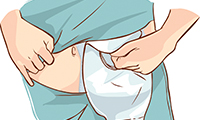Be Free Ostomy System
A New System for a New Chapter
Each year, after undergoing surgery to combat various diseases, including certain cancers, inflammatory bowel diseases, diverticulitis and a host of other conditions, about 120,000 individuals end up with an ostomy. An ostomy is an opening on the abdomen (called a stoma) that brings the intestine out through the abdominal wall, allowing waste to leave the body and collect in a disposable pouch attached to the skin. Although this is often a life-saving intervention that allows ostomates to lead healthier and more productive lives, it still comes with a cost.

Cynthia Timms
On average, ostomates need to empty their pouch four to six times a day. However, when emptied, the ostomy pouch produces a strong and distinct smell that will attract unwanted attention from surrounding people. The concern for hiding the smell can lead to anxiety, depression, and other emotional distresses for ostomates. Cynthia Timms (BSN, RN, CWOCN) nurse in Emory Healthcare in the Wound Ostomy and Continence Nursing (WOCN) Department, who ended up with an ostomy in her twenties due to Crohn's disease, recalled that she always tried to avoid her classmates at school because of that anxiety. As a result, she was determined to help herself as well as other ostomates better adjust to the lifestyle with an ostomy, and the most important step was to effectively eliminate the disturbing odor.
Although there are liquid deodorizers on the market today, their effects are usually short-lived, and they are inconvenient to use. Ostomates must reapply their liquid deodorizers many times throughout the day, forcing them to carry liquid deodorizers with them wherever they go. Even when they have deodorizers available, the release of odorous gases in public places is inevitable, causing many to often isolate themselves in social and professional situations. Given this challenge and the adverse psychological effects associated with it, Cynthia, her spouse Greg, and her partners, Ronny Bracken and George Cavagnaro, came up with the Be Free™ odor eliminating system.

Generic Ostomy Illustration
The system consists of an absorbent pod impregnated with a deodorant, both of which were developed and/or designed by Cynthia, Ronny, and George. The pod is suspended in the pouch by way of a plastic tail, which is held in place by the pouch's adhesive barrier, allowing it to remain in use for as long as the ostomate wears the pouch. The pod's odor elimination properties are further enhanced by the application of the team's liquid deodorant twice daily, or as needed, once in the morning and once in the evening before going to bed. Consequently, not only does the pod eliminate odor throughout the day without any further intervention by the ostomate, it also eliminates the need for ostomates to carry deodorants with them wherever they go.
Pilot testing of the odor elimination system has yielded very positive results. A majority of subjects not only reported significantly less odor when emptying their pouches compared to their current odor control practices, but also reported that the system's odor control properties lasted the entire day. Beyond the statistics, Cynthia has witnessed the system's positive effects on patient's lives first-hand, sharing that one study participant recorded a jingle on his answering machine to celebrate the system's effectiveness. For now, Cynthia is the biggest user of the Be Free™ system, as well as its biggest beneficiary. She no longer avoids her colleagues at work or people in social situations and is eager to share the liberation she has achieved with others. As she said, "it's been a process coming from being really afraid to empty my pouch in public to now, thirty years later, having a solution for that and wanting to share my solution with everybody."
It is anticipated that the Be Free™ system qualifies for reimbursement under Medicare and other insurance programs, which should facilitate its rapid adoption among ostomates. Cynthia is confident that this system will help improve the quality of life for many more ostomates, freeing them from the odor and psychosocial issues that so often plague ostomates as they try to navigate life after undergoing such radical changes to their bodies.
This technology was licensed to Emory start-up Bee Free Technologies.